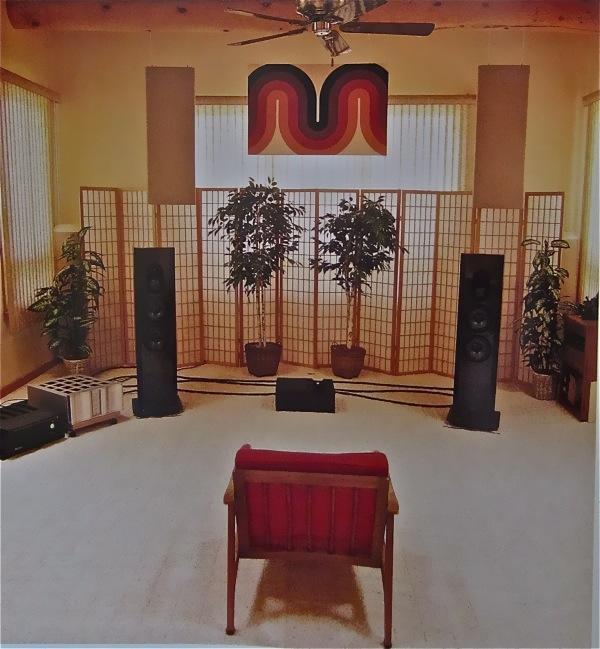Room Enough? Tales of Moving and AV Room Setup

In my time I’ve probably endured more moves than most (years in the Air Force will do that for you), so I like to think it's old hat. But it never is. It begins with packing up the old homestead and deciding what to keep and what to discard, give away, or donate. When the AF did the moving for me, that was the easy partkeep everything and figure it all out when you arrive! Ditto for when your employer pays, though when I moved from Santa Fe to California in 2000, when both Stereophile and the Stereophile Guide to Home Theater vacated our long time New Mexico digs and moved out of state, I did discard 20 or 30 trash bags full of "stuff" just to avoid a little chaos at the other end. (The Guide, as we called it for short in the biz, moved to Los Angeles with both me and our then managing editor Michael Metzger in tow, while Stereophile went to New York. The two magazines were editorially independent even before the move.)
But when you pay for a move yourself, it's not so straightforward. On my most recent move, from California to Florida, I left a lot behind, donating about half of my software collection to various charities. Most of the donated DVDs and Blu-rays were titles I'd never want to watch again (or may not have watched at alla review disc of Halloween XXIV, anyone?). I did have plans to sell about half of my LPs, and while I still might there just wasn't time to do it before moving. Yes, there are lots of used record stores in LA willing to buy old LPs, but I wasn't willing to schlep them across town in the trunk of my car only to be offered pennies on the pound. And as for my Laserdiscs (Laserdiscs??), they’re still here, along with two players. Anyone else ever tried to watch a Laserdisc lately? Compared to even a DVD, they look terrible, though 20 years ago they left us all with dropped jaws.
But enough blather. Once you get to where you're going, finding a suitable home is the first order of business. And it's not easy, even less so if your setup calls for a full home theater configuration and not just 2-channel stereo. Home architecture, particularly in modern homes, often conspires against you. Open floor plans can work, but they’re a challenge. I'm struggling with one now, with some success. And who’s with me in ganging up on the architect whose ah-ha inspiration was to put the fireplace in a corner, which often takes two walls out of the audio-video setup options?
My fireplace isn't in the corner; I'm dealing with it by covering it with acoustic panels and placing the equipment rack in front of it! Voila! No fireplace in the way! Not everyone can get away with this, of course. The audiophile wants the system and speakers to be the focal point of the room, but housemates and interior designers (sometimes one in the same), not so much. They want to put the TV over the fireplace, the worst brainstorm since the Edsel. Stiff neck, anyone? Or they propose hiding it in that vintage hutch built for a 32-inch CRT TV and can accommodate nothing larger!
When I built a house in Santa Fe (probably the best house I'll ever have for AV work) I was able to take many of these things into consideration from the start. The listening room (in the photo of a photo shown above) was created in 1993 with 2-channel listening in mind. That room was settled on first and the house literally designed around it. The main living room, entirely separate from the 2-channel listening space, was planned to be suitable for a big-screen television and a surround system, though this was a few years before I started reviewing such gear (a projection screen was added to this room later as the Guide began and evolved). The fireplace in the living room (there was no fireplace in the listening room) was on the short wall where it didn't interfere with the setup. An open, four-foot wide hallway behind the main seating position doubled as a balcony of sorts for movie nights, whenever extra seats were needed.
For my new place here in Florida I researched at least a hundred houses, though thanks to the wonders of real estate Internet sites I only visited three or four in person. The on-line photos clearly indicated that most of them were unsuitable for an optimum home theater setup. So the odds of finding the best house for a home theater are not exactly in your favor, particularly when there are other domestic priorities. The house I chose was open concept, but the main living room area was better for a home theater layout than any of the others I checked. Building from scratch was not an option this time; I didn't want to wait a year before moving in. And building a new house always costs more, with more construction headaches, than buying an existing one.
Be realistic, but don't settle for that 10' x 12' fourth bedroom for your audio-video cave if your budget and situation allows. If it's going to serve only for 2-channel stereo, you'll be better off in that room with the best headphone setup you can afford, a comfy chair, and perhaps a good pair of bookshelf speakers (on stands, not on bookshelves!) for the occasional social listening session. I have a friend in Santa Fe with a 2-channel setup and a 50-inch flat screen television in such a room, though he’s managed to squeeze in a pair of Magnepan speakers. He refers to it as his home theater closet. But if it's a multichannel home theater setup you want in such a room, good luck. Half the fun of home theater is sharing with family and friends, and that's just not easy to pull off in a tiny room.
Once you've found the right space you’ll have to figure out the best way to set things up there. Novels have been written about how to set up 2-channel and multichannel A/V systems, but the key elements are selecting the right room and taking the time to experiment with the layout. Rooms are nearly always perverse in how they treat audio systems, and 2-channel audiophiles, if they have the flexibility, play around for weeks to get just the right combination of speaker placement and listening position. If the room is to serve other purposes, and/or you live with someone else who must be happy and is more décor oriented than you, consider speakers that can be placed near the wall when not in use and moved further out into the room for listening. (Free-standing speakers almost never sound their best when pushed up against the wall unless specifically designed to be used that wayand few are. And here we’re talking primarily about free-standing speakers and not in-wall or on-wall designs.) If that eliminates the favored audiophile technique of spiking the speakers in place, so be it. The right room location is more important than spiking. Then choose a listening chair that's light enough to be moved into the optimum listening position and later repositioned if needed for social or movie purposes. Also keep in mind that a listening position directly against a wall can be as bad as misplaced speakers. For home theater a possible way around this might be a sofa on wheels or casters that can be easily moved forward or back as needed. And if you’re a serious audiophile, get rid of that big coffee table in front of the sofa, or move it out of the way when you need the system to sound its best. (Mine is on casters too!)
Unfortunately, the speaker placement options for home theater are more restricted than for 2-channel audio, as they must accommodate and complement the TV or projection screen. I'd recommend first setting up the left and right speakers for the home theater. Move them around until you find an optimum position for them, a position that will allow for the screen to fit between them and also for seating that both supports the sound and is at a comfortable viewing distance. Only then install the rest of the speakers. Setting up an entire surround system by guess and by golly, only to find out that the positioning just doesn’t work for any number of reasons, is an exercise I don’t wish on anyone. I know... I’ve tried it!
If Atmos is in your present or future plans make provision for that as well. And finally, don’t forget to allow for cable routing that doesn’t produce tripwires! Then you're done. For now!
I'll have more to say on this, and more on my current room, in later blogs and reviews. In particular, the liveliness of the room is an important factor. Should it be somewhat reflective or highly damped? The weight of opinion seems to be on the side of a neutral space, with slightly live perhaps sounding a bit better than overly dead. That's good, because a room like that is easier to achieve with normal room furnishingsupholstered furniture (fabric is better than leather for this), bookcases, rugs, drapes, etc. My current room, as it stands, is a little lively. But dialogue intelligibility is excellent, and multichannel film scores form an immense and sometimes thrilling dome of sound, entirely divorced from the speaker positions (a darkened room is a big psychoacoustic help in this). My slightly overly damped room in LA offered a bit more coherency on film scores, but not nearly a big a sonic bloom and no better dialogue reproduction. Both options were and are highly satisfying. On 2-channel sources my present room sounds closer to what I had in LA, with good imaging and no muddling from the livelier room. It’s a good start, but more remains to be done. For an audiophile/home theater fan, there’s always more to be done!
But if you're fond of bare hardwood or tile floors, and lots of uncovered glass windows, better you should consider those aforementioned headphones for your primary listeningor take up stamp collecting!

























































